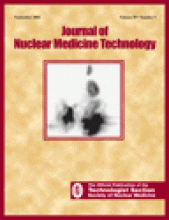Article Figures & Data
Tables
- TABLE 1
Variation of Component of Natural Background Radiation Originating from Earth’s Crust in United States and World
Annual Effective Dose (μSv) Region Cosmic radiation Terrestrial radiation Cosmic and terrestrial radiation Atlantic coast 60 160 230 Rocky Mountains 500 400 900 East, West, and Central 460 Average United States 270 280 550 Average worldwide 390 480 870 Data from (5,6).
Radioactive agent Unit effective dose* (mSv/MBq) Administered activity (MBq)† Effective dose BERT‡ 51Cr-red blood cells 2.6 × 10−1 5.5 1.4 6 mo 18F-FDG 3.0 × 10−2 185 (brain) 5.6 1.9 y 67Ga-citrate 1.1 × 10−1 185 (infection) 20.4 6.8 y 370 (tumors) 40.7 13.6 y 111In-DTPA 4.1 × 10−2 24 (cerebral spinal fluid) 1.0 4 mo 111In-white blood cells 6.4 × 10−1 25 16.0 5.3 y 123I-hippuran 2.4 × 10−2 75 1.8 7 mo 123I-sodium iodide (25% uptake) 1.2 × 10−1 10 1.2 5 mo 125I-fibrinogen 6.4 5.5 35.2 11.7 y 131I-sodium iodide (25% uptake) 6.5 0.4 2.6 10 mo 131I-MIBG 2.1 × 10−1 18 3.8 1.3 y 99mTc-bone agent 6.1 × 10−3 1110 6.8 2.3 y 99mTc-DIPIDA/HIDA 2.5 × 10−2 185 4.6 1.5 y 99mTc-DTPA 8.2 × 10−3 555 (brain) 4.6 1.5 y 370 (renal) 3.0 1 y 99mTc-DTPA aerosol 6.1 × 10−3 185 (lung) 1.1 5 mo 99mTc-DMSA 1.6 × 10−2 185 (renal) 3.0 1 y 99mTc-ECD 1.1 × 10−2 740 (brain) 8.1 2.7 y 99mTc-glucoheptonate 1.0 × 10−2 100 (renal) 1.0 4 mo 99mTc-HMPAO WBCs 2.0 × 10−2 400 8.0 2.7 y 99mTc-HMPAO 1.4 × 10−2 1110 (brain) 15.5 5.2 y 99mTc-MAA 1.3 × 10−2 185 (lung) 2.4 10 mo 99mTc-MAG3 1.2 × 10−2 185 (renal) 2.2 9 mo 99mTc-Na pertechnetate 1.1 × 10−2 111 (thyroid) 1.2 5 mo 225 (Meckel’s diverticulum) 2.5 10 mo 99mTc-pyrophosphate 6.0 × 10−3 1000 6.0 2 y 99mTc-MIBI 1.5 × 10−2 1110 (cardiac) 15.5 5.2 y 1110 (scintimammography) 15.5 5.2 y 740 (parathyroid) 11.1 3.7 y 99mTc-RBCs 7.3 × 10−3 740 (cardiovascular study) 5.4 1.8 y In vitro labeling 900 (gastrointestinal) 6.6 2.2 y 99mTc-sulfur colloid 1.4 × 10−2 400 (bone marrow) 5.6 1.9 y 140 (liver) 2.0 8 mo 99mTc-sulfur colloid aerosol 5.5 × 10−3 1000 (lung) 5.5 1.8 y 201Tl-chloride 1.6 × 10−1 140 (cardiac) 22.4 7.5 y 133Xe inhalation (5 min) 7.6 × 10−4 555 (lung) 0.4 2 mo







